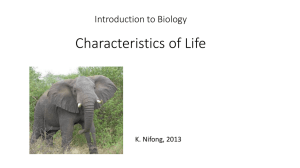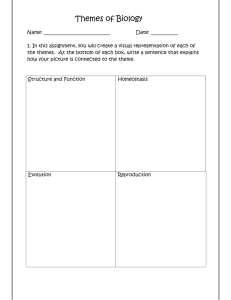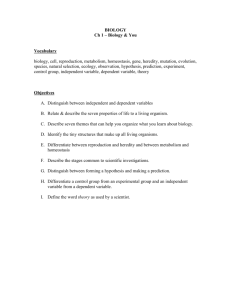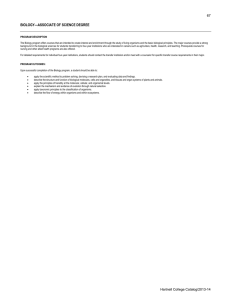Characteristics of Life L O
advertisement
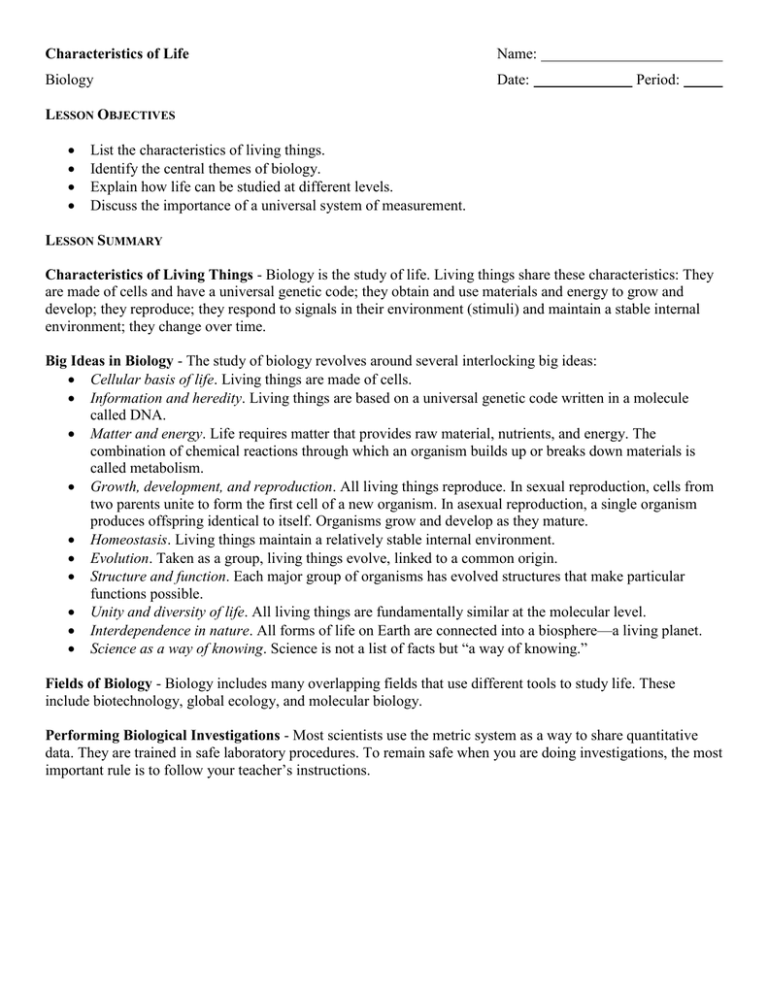
Characteristics of Life Name: Biology Date: Period: LESSON OBJECTIVES List the characteristics of living things. Identify the central themes of biology. Explain how life can be studied at different levels. Discuss the importance of a universal system of measurement. LESSON SUMMARY Characteristics of Living Things - Biology is the study of life. Living things share these characteristics: They are made of cells and have a universal genetic code; they obtain and use materials and energy to grow and develop; they reproduce; they respond to signals in their environment (stimuli) and maintain a stable internal environment; they change over time. Big Ideas in Biology - The study of biology revolves around several interlocking big ideas: Cellular basis of life. Living things are made of cells. Information and heredity. Living things are based on a universal genetic code written in a molecule called DNA. Matter and energy. Life requires matter that provides raw material, nutrients, and energy. The combination of chemical reactions through which an organism builds up or breaks down materials is called metabolism. Growth, development, and reproduction. All living things reproduce. In sexual reproduction, cells from two parents unite to form the first cell of a new organism. In asexual reproduction, a single organism produces offspring identical to itself. Organisms grow and develop as they mature. Homeostasis. Living things maintain a relatively stable internal environment. Evolution. Taken as a group, living things evolve, linked to a common origin. Structure and function. Each major group of organisms has evolved structures that make particular functions possible. Unity and diversity of life. All living things are fundamentally similar at the molecular level. Interdependence in nature. All forms of life on Earth are connected into a biosphere—a living planet. Science as a way of knowing. Science is not a list of facts but “a way of knowing.” Fields of Biology - Biology includes many overlapping fields that use different tools to study life. These include biotechnology, global ecology, and molecular biology. Performing Biological Investigations - Most scientists use the metric system as a way to share quantitative data. They are trained in safe laboratory procedures. To remain safe when you are doing investigations, the most important rule is to follow your teacher’s instructions. Characteristics of Living Things - Use pages 18-20 in your textbook. 1. Complete the graphic organizer to show the characteristics living things share. are made up of basic units called are based on a universal genetic grow, develop, and ________________ ________________ ________________ Living things respond to their ___________________ as they mature maintain a stable internal obtain and use materials and ________________ ________________ 2. The genetic molecule common to all living things is 3. The internal process of . enables living things to survive changing conditions. 4. Living things are capable of responding to different types of 5. Living things have a long history of . change. 6. The continuation of life depends of both and reproduction. 7. The combination of chemical reactions that make up an organism’s help to organize raw materials into living matter. 8. Growth occurs by cell and . Big Ideas in Biology – Read pages 20-21 to complete the following table on the Big Ideas in Biology. The first row is filled in for you. Big Idea Description Cellular basis of life Living things are made of cells. Information and heredity Life requires matter that provides raw materials, nutrients, and energy. Growth, development, and reproduction Living things maintain a relatively stable internal environment. Evolution Each major group of organisms has evolved structures that make particular functions possible. All living things are fundamentally similar at the molecular level. All forms of life on Earth are connected into a biosphere—a living planet. Science as a way of knowing Pick two of the big ideas from the chart and describe how the ideas interlock.
